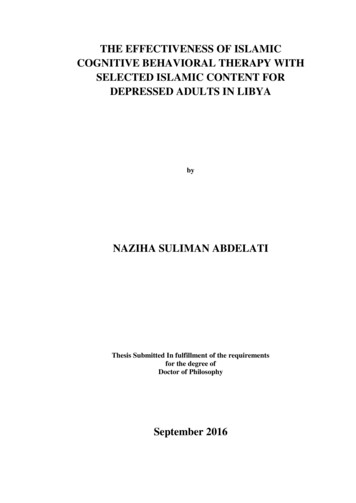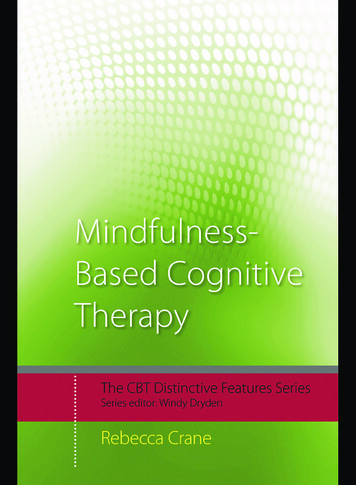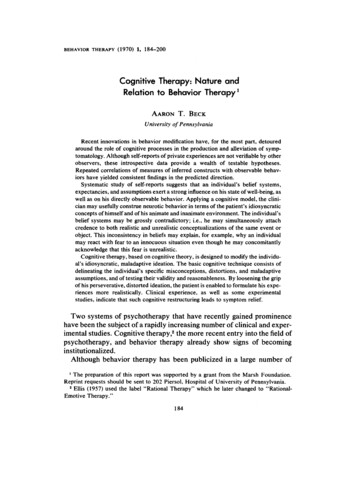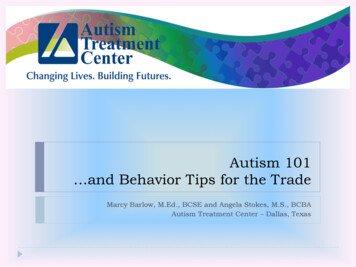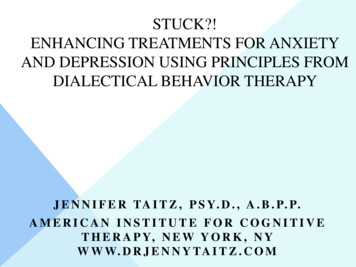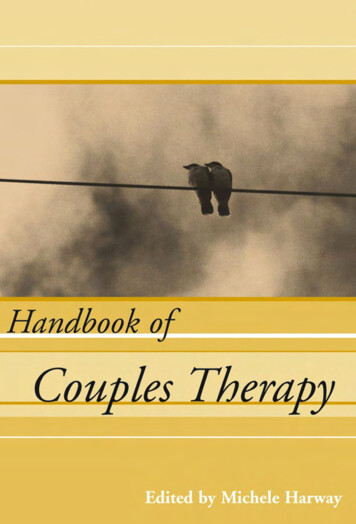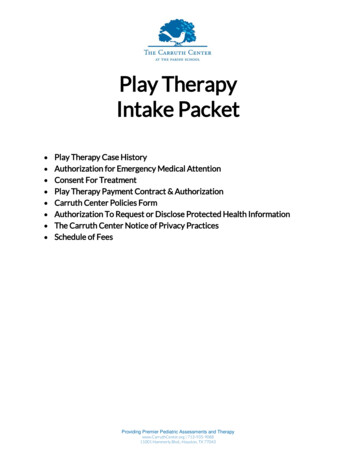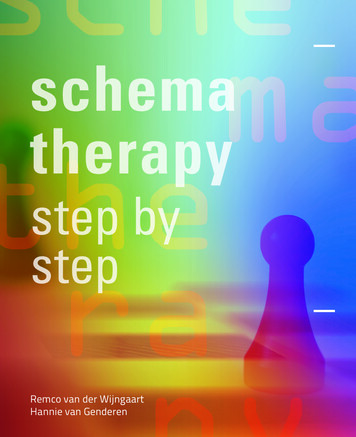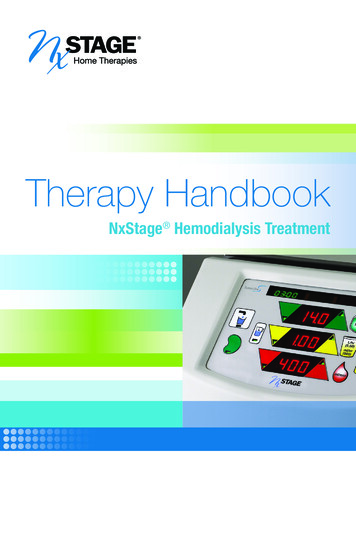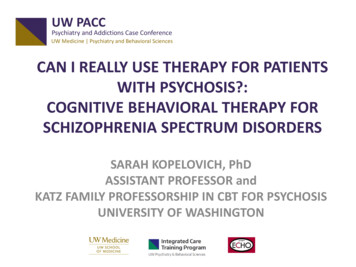
Transcription
UW PACCPsychiatry and Addictions Case ConferenceUW Medicine Psychiatry and Behavioral SciencesCAN I REALLY USE THERAPY FOR PATIENTSWITH PSYCHOSIS?:COGNITIVE BEHAVIORAL THERAPY FORSCHIZOPHRENIA SPECTRUM DISORDERSSARAH KOPELOVICH, PhDASSISTANT PROFESSOR andKATZ FAMILY PROFESSORSHIP IN CBT FOR PSYCHOSISUNIVERSITY OF WASHINGTONUW PACC 2018 University of Washington
LEARNING OBJECTIVES1. Why use psychological treatments forpsychosis?2. Briefly review the evidence base for CognitiveBehavioral Therapy for psychosis?3. Review the core principles of CBTp, thephases of treatment, and the interventionsthat are included in each phase.UW PACC 2018 University of Washington
SIGNIFICANCE Schizophrenia is the most common psychoticillness (lifetime prevalence 1:100)1 3rd most disabling health condition2 Higher rates of medical illness and mortality3– 50-90% have 1 chronic medical illness4– On average, die 28.5 years earlier, mostly frompreventable and treatable illnesses5 Individuals experiencing initial episode ofpsychosis and persistent psychosis commonlypresent in primary care setting.1McGrathet al. (2008); 2WHO (2012); 3Viron & Stern (2010); 4Gold et al. (2008); 5Olfson et al. (2015)UW PACC 2018 University of Washington
WHY USE PSYCHOLOGICAL TREATMENTS? Response: 80% have a partial response at best(Meltzer, 1992; Lally & MacCabe, 2015) Adherence: 60-80% will go off their medicationsone or more times (Fervaha et al., 2014) Impact:– medications have limited impact on:(1) beliefs that mediate recovery (hopelessness, self-stigma),(2) functional deficits(3) quality of lifeUW PACC 2018 University of Washington
Psychosocial interventions are recommended bytreatment guidelines in the U.S. Cognitive Behavioral Therapy for psychosis has thelargest evidence base– 40 RCTs– 13 meta-analysis– 4 systematic reviewsUW PACC 2018 University of Washington
WHAT DOES CBTp RESEARCH TELL US? Research shows that CBTp is an importantadjunctive treatment to psychopharmacologyfor SSDs. Overall beneficial effect on treatment targets:– Positive sx, functioning, & mood (ES .35--.65)– Continue to demonstrate gains over time– Negative sx tend to also respond but evidence lessdramatic improvementsUW PACC 2018 University of Washington
CBT FOR PSYCHOSIS CBTp aims to reduce the distress and disabilityassociated with schizophrenia spectrumdisorders. Based on the transdiagnostic cognitive model UW PACC 2018 University of Washington
COGNITIVE MODELUW PACC 2018 University of Washington
THEORY Thought disorder and Thinking disorder Hallucinations and delusions reflect automaticthoughts, which are based on relatable corebeliefs These thoughts may distort or extend reality. Theymay be interpretations of actual events or feelings.UW PACC 2018 University of Washington
CBTp PRINCIPLESUW PACC 2018 University of Washington
TWO BASIC TYPES OF CBTp1. Symptom-targeted interventions– Can apply high-yield techniques in a brief, lowintensity format to specific psychotic or relatedsymptoms2. Formulation-based CBTp– More appropriate for individuals with complexsymptom presentationsUW PACC 2018 University of Washington
“HIGH-YIELD” COGNITIVE BEHAVIORALTECHNIQUES FOR PSYCHOSISTurkington & Pelton (2014).UW PACC 2018 University of Washington
COGNITIVE THEORY:HALLUCINATIONSBeliefs maintain voices and increase associated distress– Omnipotence/power: I have to do what they say They can make bad things happen– Controllability Nothing I do makes them better– External I hear them in the walls– Credibility If they say they’ll hurt me then they will hurt me They say I’m worthless– Malevolence The voices are evil, punishing meWork of the therapy is to begin todismantle these beliefs.UW PACC 2018 University of Washington
CONCEPTUALIZING DELUSIONS Delusions are viewed as misperceptions that can be modifiedwith CBT techniques.– We are all more prone to misperceptions when understress or experiencing negative affect While rigid, most are amenable to change– Not through confrontation, but through gentle exploration with a trustedprofessional Possible to make sense of beliefs when context in which itdeveloped is understood What is the function?– avoidance, protect self-esteem, provide meaning and certainty about lifeUW PACC 2018 University of Washington
Cognitive Triad for Delusional BeliefsType of DelusionView of SelfView of Others(world)View of FutureParanoidVulnerable (inferior,defective, sociallyundesirable)Powerful, threatening;others are harmful,hostile, and malevolentHopeless, uncertainJealousUnworthy, unappealingDistrustful, exploitative;actions of others areintentionalHopelessControlWeak, powerless,helplessPowerful, omnipotent,omniscientLargely determined byothersSomaticVulnerable to harm andillnessDangerous, threatening,infectiousCharacterized oseInadequateUnrewarding; others areinferiorOptimistic, hopefulFor each category of delusions, hypothesized core beliefs are listed in relation to the components of the cognitivetriad. ( ) underlying core beliefs” (Beck, Rector, Stolar, & Grant, 2011. Appendix E, pp. 358).UW PACC 2018 University of Washington
CBT INTERVENTIONS FOR DELUSIONSBehavioral Activation & Behavioral Coping1) Reattribute beliefs2) Generate alternative beliefs3) Cognitive Restructuring: Systematically teachingclients to identify and modify unhelpful thoughts4) Behavioral experiments to further test beliefs5) Replacing the function of delusionsUW PACC 2018 University of Washington
RESOURCES FOR INDIVIDUALS WITHSCHIZOPHRENIA SPECTRUM DISORDERSUW PACC 2018 University of Washington
RESOURCES FOR LOVED ONESUW PACC 2018 University of Washington
RESOURCES FOR CBTp PRACTITIONERSUW PACC 2018 University of Washington
SUMMARY CBTp state of the research:– Respectable effect sizes for positive symptoms, insight,mood, and maintaining gains.– Poor access to CBTp (Implementation Research is needed) CBTp adheres to the same principles, structure, andgeneral theory as CBT for other presenting problems. CBTp works best when delivered as a component ofcomprehensive care. CBTp advances the culture of care for psychotic disordersin the U.S. from palliative to rehabilitative.UW PACC 2018 University of Washington
THANK YOU!CONTACT:SARAH KOPELOVICH, PHDDEPARTMENT OF PSYCHIATRY & BEHAVIORALSCIENCESEMAIL: SKOPELOV@UW.EDUUW PACC 2018 University of Washington
Cognitive Behavioral Therapy for psychosis has the . - Can apply high-yield techniques in a brief, low-intensity format to specific psychotic or related symptoms 2. Formulation-based CBTp - More appropriate for individuals with complex symptom presentations . UW PACC
